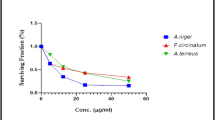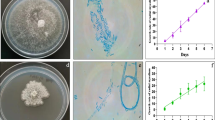Abstract
Endophytic fungal interaction with medicinal plant resulting in the production of bioactive compounds influenced the present study. Endophytic fungus Penicillium pinophilum Hedgc. from Alloteropsis cimicina with high incidence was isolated by incubation methods and characterized by morphological and molecular (ITS rDNA region) methods. Penicillium pinophilum was cultured on PD broth and metabolites of host and endophyte were extracted with ethyl acetate and methanol. Metabolites were assayed for antimicrobial potential by well diffusion and scavenging ability by spectrophotometric and electrochemical methods. Metabolite profiling by Orbitrap High-Resolution Liquid Chromatography-Mass Spectrometry and Fourier-transform infrared spectroscopy and by validation of antimicrobial and antioxidant activities in-silico drug-likeness of spectral compound prediction and molecular docking were performed. Host and P. pinophilum extracts showed strong antimicrobial potential against certain clinical bacterial strains and Fusarium oxysporum. Fungal extracts exhibited higher antioxidant activity than A. cimicina extract. Metabolite profiling indicated 14 and 21 antimicrobial, 10 and 13 antioxidant compounds in A. cimicina and P. pinophilum extracts, respectively. There were eight spectral compounds common to endophyte and host with high binding affinity towards receptors. The present study revealed that P. pinophilum and A. cimicina are natural reservoirs of novel bioactive compounds with antimicrobial and antioxidant properties.
Graphic Abstract








Similar content being viewed by others
Data availability
Data will be available online after the acceptance of the manuscript in http://www.splink.org.
References
Dwibedi V, Saxena S (2020) In vitro anti-oxidant, anti-fungal and anti-staphylococcal activity of resveratrol-producing endophytic fungi. Proc Natl Acad Sci USA 90(1):207–219
Kusari S, Hertweck C, Spiteller M (2012) Chemical ecology of endophytic fungi: origins of secondary metabolites. Chem Bio 19(7):792–798
Shweta S, Zuehlke S, Ramesha BT, Priti V, Kumar PM, Ravikanth G, Spiteller M, Vasudeva R, Shaanker RU (2010) Endophytic fungal strains of Fusarium solani, from Apodytes dimidiata E. Mey ex Arn (Icacinaceae) produce camptothecin, 10-hydroxycamptothecin and 9-methoxycamptothecin. Phytochemistry 71(1):117–122
Sette LD, Passarini MRZ, Delarmelina C, Salati F, Duarte MCT (2006) Molecular characterization and antimicrobial activity of endophytic fungi from coffee plants. World J Microb Biot 22(11):1185–1195
Qin S, Li J, Chen HH, Zhao GZ, Zhu WY, Jiang CL, Xu LH, Li WJ (2009) Isolation, diversity, and antimicrobial activity of rare actinobacteria from medicinal plants of tropical rain forests in Xishuangbanna. China App Environ Microbial 75(19):6176–6186
Katewa SS, Guria BD, Jain A (2001) Ethnomedicinal and obnoxious grasses of Rajasthan, India. J Ethnopharmacol 76:293–297
Vasanthakumari MM, Shivanna MB (2009) Fungal assemblages in the rhizosphere and rhizoplane of grasses of the subfamily Panicoideae in the Lakkavalli region of Karnataka India. Microb Environ. https://doi.org/10.1264/jsme2.me10163
Nischitha R, Shivanna MB (2020) Influence of seasons on endophytic fungal assemblage in Alloteropsis cimicina (L.) Stapf. and Heteropogon contortus (L.) P. Beauv. of the sub-family panicoideae. Curr Res Environ Appl Mycol J Fungal Biol 10(1):10–25
Bhat KG, Nagendran CR (2001) Sedges and Grasses (Dakshina Kannada and Udupi districts). Dehra Dun, Bishen Singh Mahendra Pal Singh (Ed): 341
Schulz B, Wanke U, Draeger S, Aust HJ (1993) Endophytes from herbaceous plants and shrubs, effectiveness of surface sterilization methods. Mycol Res 9:1447–1450
Arx Von JA (1981) On Monilia sitophila and some families of Ascomycetes. Sydowia Ann Mycologici 34:12–29
Nischitha R, Vasanthkumari MM, Kumaraswamy BE, Shivanna MB (2020) Antimicrobial and antioxidant activities and chemical profiling of Curvularia tsudae endophytic in Cynodon dactylon (L.) Pers. 3 Biotech 10(7):1–12
Nischitha R, Shivanna MB (2021) Antimicrobial activity and metabolite profiling of endophytic fungi in Digitaria bicornis (Lam) Roem. & Schult. and Paspalidium flavidum (Retz.) A. Camus. 3 Biotech 11(2):1–15
Gagana SL, Kumaraswamy BE, Shivanna MB (2020) Diversity, antibacterial and antioxidant activities of the fungal endophytes associated with Schleichera oleosa (Lour.) Merr. S Afr J Bot 134:369–381
Blois MS (1958) Antioxidant determinations by the use of a stable free radical. Nature 181(4617):1199–1200
Arulpriya P, Lalitha P, Hemalatha S (2010) Cyclic voltammetric assessment of the antioxidant activity of petroleum ether extract of Samanea saman (Jacq.) Merr. Pelagia. Res Libr 1(3):24–35
Koleva Y, Georgieve S, Agova N, Iliev I (2019) Molecular properties and bioactivity score of newly synthesized derivatives of bexarotene. Proc Uni Rus 58:2–10
Nayab RS, Maddila S, Krishna MP, Titinchi SJ, Thaslim BS, Chintha V, Chamarthi NR (2020) In silico molecular docking and in vitro antioxidant activity studies of novel α-aminophosphonates bearing 6-amino-1, 3-dimethyl uracil. J Recept Signal Transduct 40(2):166–172
Vinale F, Nicoletti R, Lacatena F, Marra R, Sacco A, Lombardi N, d’Errico G, Digilio MC, Lorito M, Woo SL (2017) Secondary metabolites from the endophytic fungus Talaromyces pinophilus. Nat Prod Res 31(15):1778–1785
Koul M, Meena S, Kumar A, Sharma PR, Singamaneni V, Riyaz-Ul-Hassan S, Hamid A, Chaubey A, Prabhakar A, Gupta P, Singh S (2016) Secondary metabolites from endophytic fungus Penicillium pinophilum induce ROS-mediated apoptosis through mitochondrial pathway in pancreatic cancer cells. Planta med 82(04):344–355
Yasser MM, Marzouk MA, El-Shafey NM, Shaban SA (2020) Diversity and antimicrobial activity of endophytic fungi from the medicinal plant Pelargonium graveolens (geranium) in Middle Egypt. Jordan J Biol Sci 13(2):197
George TK, Joy A, Divya K, Jisha MS (2019) In vitro and in silico docking studies of antibacterial compounds derived from endophytic Penicillium setosum. Microb Pathogen 131:87–97
Danagoudar A, Joshi CG, Sunil Kumar R, Poyya J, Nivya T, Hulikere MM, Anu Appaiah KA (2017) Molecular profiling and antioxidant as well as anti-bacterial potential of polyphenol producing endophytic fungus-Aspergillus austroafricanus CGJ-B3. Mycol 8(1):28–38
Govindappa M, Lavanya M, Aishwarya P, Pai K, Lunked P, Hemashekhar B, Arpitha BM, Ramachandra YL, Raghavendra VB (2020) Synthesis and characterization of endophytic fungi, Cladosporium perangustum mediated silver nanoparticles and their antioxidant, anticancer and nano-toxicological study. Bio Nano Sci 10:1–14
Rebiai A, Lanez T, Belfar ML (2011) In vitro evaluation of antioxidant capacity of algerian propolis by spectrophotometrical and electrochemical assays. Int J Pharmacol 7:113–118
Amamra S, Cartea ME, Belhaddad OE, Soengas P, Baghiani A, Arrar KI, L, (2018) Determination of total phenolics contents, antioxidant capacity of Thymus vulgaris extracts using electrochemical and spectrophotometric methods. Int J Electrochem Sci 13:7882–7893
Do E, Lee HG, Park M, Cho YJ, Kim DH, Park SH, Eun D, Park T, An S, Jung WH (2019) Antifungal mechanism of action of lauryl betaine against skin-associated fungus Malassezia restricta. Mycobiol 47(2):242–249
de Oliveira Filho JWG, Andrade TDJADS, de Lima RMT, Silva DHS, Dos Reis AC, Santos JVDO, de Meneses AAPM, de Carvalho RM, da Mata AMO, de Alencar MVOB, Dias ACS (2020) Cytogenotoxic evaluation of the acetonitrile extract, citrinin and dicitrinin-A from Penicillium citrinum. Drug Chem Toxicol. https://doi.org/10.1080/01480545.2020.1769642
Ertl P, Rohde B, Selzer P (2000) Fast calculation of molecular polar surface area as a sum of fragment-based contributions and its application to the prediction of drug transport properties. J Med Chem 43:3714–3717
Singh V, Praveen V, Tripathi D, Haque S, Somvanshi P, Katti SB, Tripathi CKM (2015) Isolation, characterization and antifungal docking studies of wortmannin isolated from Penicillium radicum. Sci Rep 5(1):1–13
Acknowledgements
The first author thanks the National Fellowship for Scheduled Caste (NFSC), UGC, New Delhi for awarding Senior Research Fellowship and also thankful to SAIF, IIT, Bombay for OHR LC-MS and FTIR service.
Funding
The research was funded by the University Grants Commission (NFSC) RGNF-2017–18-SC-KAR-38457.
Author information
Authors and Affiliations
Contributions
MBS conceived the initial work idea and NR performed the laboratory experiments and data analysis. MBS and NR worked on the data interpretation of the work. NR prepared the first draft copy of the manuscript and the corrections were made and finalized by MBS and approved the final manuscript.
Corresponding author
Ethics declarations
Conflict of interest
The authors declare no competing financial interest.
Additional information
Publisher's Note
Springer Nature remains neutral with regard to jurisdictional claims in published maps and institutional affiliations.
Supplementary Information
Below is the link to the electronic supplementary material.
Rights and permissions
About this article
Cite this article
Nischitha, R., Shivanna, M.B. Metabolite fingerprinting, in vitro antimicrobial and antioxidant activities and in-silico docking in Alloteropsis cimicina and its endophytic fungus Penicillium pinophilum. Mol Biol Rep 48, 4021–4037 (2021). https://doi.org/10.1007/s11033-021-06410-0
Received:
Accepted:
Published:
Issue Date:
DOI: https://doi.org/10.1007/s11033-021-06410-0




